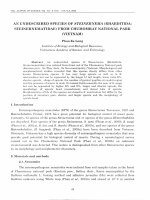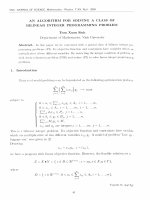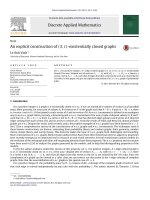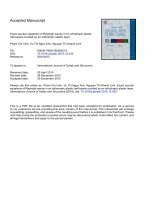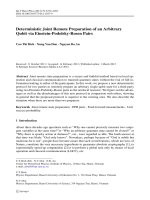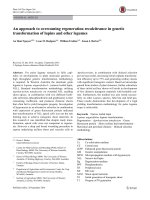DSpace at VNU: An approximate secular equation of Rayleigh waves in an isotropic elastic half-space coated with a thin isotropic elastic layer
Bạn đang xem bản rút gọn của tài liệu. Xem và tải ngay bản đầy đủ của tài liệu tại đây (234.17 KB, 9 trang )
Acta Mech
DOI 10.1007/s00707-014-1090-8
Chi Vinh Pham · Thi Ngoc Anh Vu
An approximate secular equation of Rayleigh waves
in an isotropic elastic half-space coated with a thin
isotropic elastic layer
Received: 28 October 2013 / Revised: 25 December 2013
© Springer-Verlag Wien 2014
Abstract In this paper, we are interested in the propagation of Rayleigh waves in an isotropic elastic halfspace coated with a thin isotropic elastic layer. The contact between the layer and the half-space is assumed
to be welded. The main purpose of the paper is to establish an approximate secular equation of the wave.
By using the effective boundary condition method, an approximate secular equation of fourth order in terms
of the dimensionless thickness of the layer is derived. It is shown that this approximate secular equation has
high accuracy. From the secular equation obtained, an approximate formula of third order for the velocity of
Rayleigh waves is established.
1 Introduction
The structures of a thin film attached to solids, modeled as half-spaces coated by a thin layer, are widely
applied in modern technology. The determination of mechanical properties of thin films deposited on halfspaces before and during loading plays an important role in health monitoring of these structures [1,2]. Among
various measurement methods, the surface/guided wave method is most widely used [2], and for this method,
the Rayleigh wave is a versatile and convenient tool [3,4].
For the Rayleigh wave approach, the explicit dispersion relations of Rayleigh waves supported by thin
film/substrate interactions are employed as theoretical bases for extracting the mechanical properties of the
thin films from experimental data. They are therefore the main purpose of the investigations of Rayleigh waves
propagating in half-spaces covered with a thin layer. Taking the assumption of a thin layer, explicit secular
equations can be derived by replacing the entire effect of the thin layer on the half-space by the so-called
effective boundary conditions, which relate the displacements with the stresses of the half-space at its surface.
For obtaining the effective boundary conditions, Achenbach and Keshava [5], and Tiersten [6] replaced the
thin layer by a plate modeled by different theories: Mindlin’s plate theory and the plate theory of low-frequency
extension and flexure, while Bovik [7] expanded the stresses at the top surface of the layer into Taylor series in
its thickness. The Taylor expansion technique was then developed by Rokhlin and Huang [8,9], Niklasson [10],
Benveniste [11], Steigmann and Ogden [12], Ting [13], Vinh and Linh [14,15], Vinh and Anh [16] and Vinh et
al. [17]. Malischewsky [18] puts Tiersten’s theory into a broader context by formulating very general impedance
conditions. Godoy et al. [19] used Malischewsky’s formalism for a similar problem with vanishing normal
traction on the surface.
Tiersten [6] and Bovik [7] assumed that the layer and the substrate are both isotropic and derived approximate secular equations of second order. In Vinh and Linh [14], the layer and the half-space were both assumed
C. V. Pham (B) · T. N. A. Vu
Faculty of Mathematics, Mechanics and Informatics, Hanoi University of Science,
334, Nguyen Trai Str., Thanh Xuan, Hanoi, Vietnam
E-mail: ;
Tel.: +84-4-35532164
Fax: +84-4-38588817
C. V. Pham, T. N. A. Vu
to be orthotropic, and an approximate secular equation of third order was obtained. In order to get more accurate solutions of the inverse problem (evaluating the mechanical properties of the thin films from experimental
data), we need approximate secular equations of higher order.
The main purpose of this paper is to establish an approximate secular equation of fourth order of Rayleigh
waves propagating in an isotropic half-space coated with a thin isotropic elastic layer. The contact between
the layer and the half-space is assumed to be welded. Starting from the basic equations in matrix form and
employing the Taylor expansion technique, the effective boundary conditions are derived. With these boundary conditions, the fourth-order approximate secular equation is obtained by considering the propagation of
Rayleigh waves in the half-space without the layer. It is shown that this approximate secular equation has
high accuracy, and it is much more better than Bovik’s second-order approximate dispersion relation. From
the secular equation obtained, an approximate formula of third order for the velocity of Rayleigh waves is
established.
Note that, Achenbach and Keshava [5] derived an approximate secular of fourth order for the isotropic
case. However, this approximate secular equation includes the shear coefficient, originating from Mindlin’s
plate theory [20], whose usage should be avoided as noted by Touratier [21], Muller and Touratier [22] and
Stephen [23].
2 Effective boundary condition of fourth order
Consider an elastic half-space x3 ≥ 0 coated by a thin elastic layer −h ≤ x3 ≤ 0. The layer and the half-space
are both homogeneous, compressible and isotropic. The layer is assumed to be perfectly bonded to the halfspace. Note that the respective quantities related to the half-space and the layer have the same symbol but are
systematically distinguished by a bar if pertaining to the layer. We consider a plane motion in the (x1 , x3 )-plane
with displacement components (u 1 , u 2 , u 3 ) such that
u i = u i (x1 , x3 , t), u¯ i = u¯ i (x1 , x3 , t), i = 1, 3, u 2 = u¯ 2 ≡ 0,
(1)
where t is the time. Since the layer is made of isotropic elastic materials, the strain–stress relations take the
form
σ¯ 11 = (λ¯ + 2μ)
¯ u¯ 1,1 + λ¯ u¯ 3,3 ,
¯ u¯ 3,3 ,
σ¯ 33 = λ¯ u¯ 1,1 + (λ¯ + 2μ)
¯ u¯ 1,3 + u¯ 3,1 ),
σ¯ 13 = μ(
(2)
where σ¯ i j is the stress of the layer, commas indicate differentiation with respect to spatial variables xk and λ¯
and μ¯ are Lamé constants. In the absent of body forces, the equations of motion for the layer are:
σ¯ 11,1 + σ¯ 13,3 = ρ¯ u¨¯ 1 ,
σ¯ 13,1 + σ¯ 33,3 = ρ¯ u¨¯ 3 ,
(3)
where a dot signifies differentiation with respect to t. From Eqs. (2), (3), we have
U¯
T¯
=
M1 M2
U¯
M3 M4
T¯
,
(4)
where
U¯ = u¯ 1 u¯ 3
T
, T¯ = σ¯ 13 σ¯ 33
T
,
the symbol “T ” indicate the transpose of a matrix, the prime signifies differentiation with respect to x3 , and
⎡
⎡1
⎤
⎤
0
−∂1
0
⎢
⎢ μ¯
⎥
⎥
M1 = ⎣ −λ¯
⎦ , M2 = ⎣
1 ⎦,
∂1 0
0
¯
λ¯ + 2μ¯
⎡
⎤λ + 2μ¯
(5)
2
(λ¯ + 2μ)
¯ − λ¯ 2 2
2
¯ t
0 ⎥
∂1 + ρ∂
⎢−
M3 = ⎣
λ¯ + 2μ¯
⎦ , M4 = M1 T .
0
ρ∂
¯ t2
An approximate secular equation of Rayleigh waves
Here, we use the notations ∂1 = ∂/∂ x1 , ∂12 = ∂ 2 /∂ x1 2 , ∂t2 = ∂ 2 /∂t 2 . Equation (4) is called the matrix form
of basic equations (see also Vinh and Seriani [24,25]). From (4), it follows that
U¯ (n)
T¯ (n)
= Mn
U¯
T¯
⎡
, M =⎣
M1 M2
⎤
⎦ , n = 1, 2, 3, . . . , x3 ∈ [−h, 0].
(6)
M3 M4
Let h be small (i. e. the layer is thin), then expanding into a Taylor series T¯ (−h) at x3 = 0 up to the fourth
order of h, we have:
1
1
1
T¯ (−h) = T¯ (0) − T¯ (0)h + T¯ (0)h 2 − T¯ (0)h 3 + h 4 T¯ (0).
2!
3!
4!
(7)
Suppose that the surface x3 = −h is free of traction, i.e., T¯ (−h) = 0. Introducing (6) with n = 1, 2, 3, 4 at
x3 = 0 into (7) yields
1
1
1
I − h M4 + h 2 M6 − h 3 M8 + h 4 M10 T¯ (0)
2
6
24
1
1
1
= h M3 − h 2 M5 + h 3 M7 − h 4 M9 U¯ (0),
2
6
24
(8)
where I is the identity matrix of order 2. Since the layer and the half-space are bonded perfectly to each other
at the plane x3 = 0, if follows that U¯ (0) = U (0), T¯ (0) = T (0). From (8), we have
1
1
1
I − h M4 + h 2 M6 − h 3 M8 + h 4 M10 T (0)
2
6
24
1 2
1 3
1
= h M3 − h M5 + h M7 − h 4 M9 U (0).
2
6
24
(9)
M3 , M4 are defined by (5) and
M5 = M3 M1 + M4 M3 ,
M6 = M3 M2 + M42 ,
M7 = M3 M12 + M4 M3 M1 + M3 M2 M3 + M42 M3 ,
M8 = M3 M1 M2 + M4 M3 M2 + M3 M2 M4 + M43 ,
M9 = M3 M13 + M4 M3 M12 + M3 M2 M3 M1 + M42 M3 M1
(10)
+ M3 M1 M2 M3 + M4 M3 M2 M3 + M3 M2 M4 M3 + M43 M3 ,
M10 = M3 M12 M2 + M4 M3 M1 M2 + M3 M2 M3 M2 + M42 M3 M2
+ M3 M1 M2 M4 + M4 M3 M2 M4 + M3 M2 M42 + M44 .
The relation (9) between the traction vector and displacement vector of the half-space at the plane x3 = 0 is
called effective boundary condition of fourth order in the matrix form. It replaces (approximately) the entire
effect of the thin layer on the substrate. Introducing (5) and (10) into (9), we obtain the effective boundary
conditions of fourth order in component form, namely
C. V. Pham, T. N. A. Vu
σ13 + h (1 − 2γ¯ )σ33,1 + 4ρ¯ c¯22 (1 − γ¯ )u 1,11 − ρ¯ u¨ 1
+
h2
1
¯ − γ¯ )u¨ 3,1
(2γ¯ − 3)σ13,11 + 2 σ¨ 13 + 4ρ¯ c¯22 (1 − γ¯ )u 3,111 − 2ρ(1
2
c¯2
+
h3
6
(4γ¯ − 3)σ33,111 +
+ ρ(5
¯ − 4γ¯ 2 )u¨ 1,11 −
+
1
2
(1 − γ¯ ) + 2 (1 − 2γ¯ ) σ¨ 33,1 − 8ρ¯ c¯22 (1 − γ¯ )u 1,1111
2
c¯1
c¯2
ρ¯
u¨ 1,tt
c¯22
+
h4
1
1
(5 − 4γ¯ )σ13,1111 + 2 2 (1 − γ¯ ) + 2 (2γ¯ 2 − γ¯ − 2) σ¨ 13,11
24
c¯1
c¯2
1
1
1
σ¨ 13,tt + 4ρ(2
¯ − γ¯ − γ¯ 2 )u¨ 3,111 − 8ρ¯ c¯22 (1 − γ¯ )u 3,11111 − 2ρ(1
¯ − γ¯ ) 2 + 2
4
c¯2
c¯1
c¯2
u¨ 3,1tt
=0
at x3 = 0,
σ33 + h(σ13,1 − ρ¯ u¨ 3 )
(11)
+
h2
1
¯ − γ¯ )u¨ 1,1
(1 − 2γ¯ )σ33,11 + 2 σ¨ 33 + 4ρ¯ c¯22 (1 − γ¯ )u 1,111 − 2ρ(1
2
c¯1
+
h3
6
+
1
1
h4
1
(4γ¯ − 3)σ33,1111 + 2 (4 − 6γ¯ ) + 2 (2 − 6γ¯ + 4γ¯ 2 ) σ¨ 33,11 + 4 σ¨ 33,tt
24
c¯1
c¯2
c¯1
(2γ¯ − 3)σ13,111 +
2
1
ρ¯
(1 − γ¯ ) + 2 σ¨ 13,1 + 4ρ¯ c¯22 (1 − γ¯ )u 3,1111 − ρ(3
¯ − 4γ¯ )u¨ 3,11 − 2 u¨ 3,tt
2
c¯2
c¯1
c¯1
+ 4ρ(2
¯ − γ¯ − γ¯ 2 )u¨ 1,111 − 8ρ¯ c¯22 (1 − γ¯ )u 1,11111 − 2ρ(1
¯ − γ¯ )
1
1
+ 2
c¯12
c¯2
u¨ 1,1tt
=0
at x3 = 0,
(12)
where
c¯1 =
λ¯ + 2μ¯
, c¯2 =
ρ¯
c¯2
μ¯
, γ¯ = 22 .
ρ¯
c¯1
(13)
3 An approximate secular equation of fourth order
Now, we ignore the layer and consider the propagation of a Rayleigh wave in the half-space subjected the
boundary conditions (11) and (12). The Rayleigh wave travels with velocity c (>0) and wave number k (>0)
in the x1 -direction and decays in the x3 -direction, i.e., its displacements and stresses vanish at x3 = +∞.
According to Achenbach [26], the displacements and stresses of Rayleigh wave satisfying (4) (without bars)
and the decay condition are given by
u 1 = B1 e−kb1 x3 + B2 e−kb2 x3 eik(x1 −ct) ,
u 3 = α1 B1 e−kb1 x3 + α2 B2 e−kb2 x3 eik(x1 −ct) ,
(14)
σ13 = −kc22 ρ (b1 + β1 )B1 e−kb1 x3 + (b2 + β2 )B2 e−kb2 x3 eik(x1 −ct) ,
1
1
1
1
− 2 − b1 β1 B1 e−kb1 x3 +
− 2 − b2 β2 B2 e−kb2 x3 eik(x1 −ct) ,
γ
γ
γ
γ
where B1 and B2 are constants to be determined, and
√
1
b1 = 1 − γ x, b2 = 1 − x, αk = iβk , β1 = b1 , β2 = , k = 1, 2,
b2
σ33 = kic22 ρ
γ =
c22
c12
, c1 =
λ + 2μ
, c2 =
ρ
μ
c2
, x = 2 , 0 < x < 1.
ρ
c2
(15)
(16)
An approximate secular equation of Rayleigh waves
Introducing (14), (15) into the effective boundary conditions (11), (12) leads to the following equation for
B1 , B2 :
f (b1 )B1 + f (b2 )B2 = 0,
F(b1 )B1 + F(b2 )B2 = 0,
(17)
where:
f (bn ) = −(bn + βn ) + ε 4rμ (γ¯ − 1) + rμrv2 x + (2γ¯ − 1)
ε2
2
ε3
+
6
+
1
1
− 2 − b n βn
γ
γ
(2γ¯ − 3) + xrv2 (bn + βn ) − βn 4rμ (γ¯ − 1) + 2(1 − γ¯ )rμrv2 x
1
1
− 2 − b n βn
γ
γ
(4γ¯ − 3) + (1 − 2γ¯ 2 )xrv2 − (4γ¯ 2 − 5)rμrv2 x
− 8rμ (1 − γ¯ ) − rμrv4 x 2 +
ε4
24
(4γ¯ − 5) + 2(2 − γ¯ 2 )xrv2 − x 2 rv4 (bn + βn )
− βn 8rμ (γ¯ − 1) + 4(2 − γ¯ − γ¯ 2 )xrv2 rμ − 2(1 − γ¯ 2 )rμrv4 x 2 ,
1
−2−
γ
ε2
+
(2γ¯
2
ε3
(2γ¯
+
6
F(bn ) =
+ x 2 rv4 rμ γ¯
1
bn βn + ε − (bn + βn ) + rμrv2 xβn
γ
1
1
− 1) − x γ¯ rv2
− 2 − bn βn − 4rμ (1 − γ¯ ) + 2(1 − γ¯ )xrμrv2
γ
γ
(18)
− 3) + (2 − γ¯ )xrv2 (bn + βn ) − βn 4(γ¯ − 1)rμ + (3 − 4γ¯ )xrv2 rμ
+
ε4
24
(4γ¯ − 3) + 2(1 − γ¯ − γ¯ 2 )xrv2 + x 2 rv4 γ¯ 2
1
1
− 2 − b n βn
γ
γ
+ 4(2 − γ¯ − γ¯ 2 )xrv2 rμ − 8(1 − γ¯ )rμ − 2(1 − γ¯ 2 )x 2 rv4 rμ ,
μ¯
c2
, rv = .
μ
c¯2
Due to B12 + B22 = 0, the determinant of coefficients of the homogeneous system (17) must vanish. This
provides:
f (b1 )F(b2 ) − f (b2 )F(b1 ) = 0.
(19)
n = 1, 2, ε = kh, rμ =
From (18) and (19), after algebraically lengthy calculations whose detail omitted, we arrive at the approximate
secular equation of fourth order of Rayleigh waves, namely
A0 + A1 ε + A2 ε2 + A3 ε3 + A4 ε4 + O(ε5 ) = 0,
(20)
where ε = kh is called the dimensionless thickness of the layer, and
A0 = (2 − x)2 − 4b1 b2 ,
A1 = xrμ [rv2 x − 4(1 − γ¯ )]b2 + rv2 xb1 ,
A2 =
1
− A0 xrv2 (1 + γ¯ ) − 4(1 − γ¯ ) + 2rμ2 rv2 x 4(1 − γ¯ ) − rv2 x (1 − b1 b2 )
2
+ 2rμ (2b1 b2 − 2 + x) 4(1 − γ¯ ) − 2rv2 x γ¯
,
1
A3 = − xrμ [(γ¯ + 3)rv4 x 2 + 4(2γ¯ − 3)rv2 x + 8(1 − γ¯ )]b1 + [(3γ¯ + 1)rv4 x 2
6
+ 4(γ¯ 2 − 2)rv2 x + 8(1 − γ¯ )]b2 ,
(21)
C. V. Pham, T. N. A. Vu
0.95
0.9
0.85
x
1/2
0.8
0.75
0.7
0.65
0.6
0.55
0.5
0
0.5
ε
1
1.5
√
Fig. 1 Plots of the dimensionless Rayleigh wave velocity x = c/c2 in the interval ε ∈ [0 1.5] that are calculated by the exact
secular equation (6) in Ref. [7] (solid line), by Bovik’s second-order approximate secular equation (Eq. 38, Ref. [7]) (dash-dot line)
and by the approximate secular equation of fourth-order (24) (dashed line). Here we take rμ = 1.9266, rv = 1.6070, γ = 0.3556
and γ¯ = 0.2258
A4 =
1
A0 8(1 − γ¯ 2 ) − 8xrν2 − 12xrν2 γ¯ + 12xrν2 γ¯ 2 + x 2 rν4 + 6x 2 rν4 γ¯
24
1
+x 2 rν4 γ¯ 2 + (1 − b1 b2 ) − 8rμ2 (γ¯ − 1)2 + 8rμ2 rν2 x(2 − 3γ¯ + γ¯ 2 )
6
+ 2rμ2 rν4 x 2 (γ¯ 2 + 2γ¯ − 4) + rμ2 rν6 x 3 (1 + γ¯ ) + 16rμ γ¯ (γ¯ − 1)
1
+ b1 b2 rμrν2 rν2 x 2 (γ¯ 2 + 4γ¯ − 1) + 2x(1 − 8γ¯ + 5γ¯ 2 )
3
1
+ rμ x rν4 (γ¯ 2 + 4γ¯ − 1)(x 2 − 2x) + 2rν2 (1 − 8γ¯ + 5γ¯ 2 )(x − 2) − 8γ¯ (γ¯ − 1) .
6
(22)
Since A0 [x(ε)] = O(ε), from (22), it follows that A4 ε4 = A∗4 ε4 + O(ε5 ), where
A∗4 =
1
(1 − b1 b2 ) − 8rμ2 (γ¯ − 1)2 + 8rμ2 rv2 x(2 − 3γ¯ + γ¯ 2 )
6
+2rμ2 rv4 x 2 (γ¯ 2 + 2γ¯ − 4) + rμ2 rv6 x 3 (1 + γ¯ ) + 16rμ γ¯ (γ¯ − 1)
1
+ b1 b2 rμrv2 rv2 x 2 (γ¯ 2 + 4γ¯ − 1) + 2x(1 − 8γ¯ + 5γ¯ 2 )
3
1
+ rμ x rv4 (γ¯ 2 + 4γ¯ − 1)(x 2 − 2x) + 2rv2 (1 − 8γ¯ + 5γ¯ 2 )(x − 2) − 8γ¯ (γ¯ − 1) .
6
Therefore, Eq. (20) can be written as
A0 + A1 ε + A2 ε2 + A3 ε3 + A∗4 ε4 + O(ε5 ) = 0.
(23)
(24)
Equations (20) and (24) are the desired approximate secular equations. Up to the third order of ε, Eqs. (20)
and (24) coincide with Eq. (38) in Ref. [14]. Taking into account the fact that A0 [x(ε)] = O(ε), one can see
that up to the second order, Eqs. (20), (24) and Bovik’s second-order approximation (Eq. 38 in Ref. [7]) are
identical to each other and they coincide with Eq. (43) in Ref. [14].
√
Figure 1 presents the dependence on ε ∈ [0 1.5] of the dimensionless Rayleigh wave velocity x = c/c2
that is calculated by the exact secular equation (6) in Ref. [7] by Bovik’s second-order approximate secular
equation (Eq. 38, Ref. [7]) and by the approximate secular equation of fourth order (24). Here, we take
rμ = 1.9266, rv = 1.6070, γ = 0.3556 and γ¯ = 0.2258.
It is seen from Fig. 1 that the exact velocity curve and the approximate velocity curve of fourth order
almost totally coincide with each other. That means the fourth-order approximate secular equation (24) has
high accuracy. Figure 1 also shows that it is much better than Bovik’s second-order approximate secular
equation.
An approximate secular equation of Rayleigh waves
4 An approximate formula of third order for the velocity
In this section, we establish an approximate formula of third order for the squared dimensionless Rayleigh
wave velocity x(ε) that is of the form
x(ε) = x(0) + x (0) ε +
x (0) 2 x (0) 3
ε +
ε + O(ε4 ),
2
6
(25)
where x(0) is the squared dimensionless velocity of Rayleigh waves propagating in an isotropic elastic halfspace that is given by [27]
4
x(0) = 4(1 − γ ) 2 − γ +
3
3
R+
√
D+
3
R−
√
−1
D
,
(26)
in which
R = 2(27 − 90γ + 99γ 2 − 32γ 3 )/27,
(27)
D = 4(1 − γ )2 (11 − 62γ + 107γ 2 − 64γ 3 )/27,
the roots in the formula (26) taking their principal values.
From (20), it follows that
x (0) = −
A1
A0x
, x (0) = −
2 A2 A20x − 2 A0x A1 A1x + A0x x A21
x=x(0)
A30x
,
x=x(0)
(28)
x (0) = − 6A3 + 6A2x x (0) + 3A1x x x 2 (0) + 3A1x x (0)
+ 3A0x x x (0)x (0) + A0x x x x 3 (0) /A0x
x=x(0)
,
where A1 , A2 and A3 are given by (21) and
1 + γ − 2γ x
, A0x x = 2 +
A0x = 2 x − 2 + √
√
1− x 1−γx
1 + γ − 2γ x
,
A0x x x = 3(γ − 1)2
2 (1 − x)5 (1 − γ x)5
(γ − 1)2
(1 − x)3 (1 − γ x)3
,
rv2 x(4 − 5x) + 12x(1 − γ¯ ) − 8(1 − γ¯ ) rv2 x(4 − 5γ x)
,
+
√
√
2 1−γx
2 1−x
r 2 (8 − 24x + 15x 2 ) + 4(1 − γ¯ )(4 − 3x) rv2 (8 − 24γ x + 15γ¯ 2 x 2 )
,
= rμ v
+
4 (1 − γ x)3
4 (1 − x)3
1
1
= − rv2 (1 + γ¯ )A0 − (1 + γ¯ )rv2 x − 4(1 − γ¯ ) A0x
2
2
√
2
+ 2rμrv 1 − 1 − x 1 − γ x rμ (2 − 2γ¯ − rv2 x) + 2γ¯ − γ¯ x
A1x = rμ
A1x x
A2x
(29)
1 + γ − 2γ x
1
+ rμ2 rv2 x 4(1 − γ¯ ) − rv2 x √
√
2
1− x 1−γx
1 + γ − 2γ x
2(1 − γ¯ ) − rv2 x γ¯ .
+ 2rμ 1 − √
√
1− x 1−γx
Note that, x(0) can be calculated by another exact formula derived by Malischewsky [28] or by the approximate
expressions with high accuracy obtained recently by Vinh and Malischewsky [29–31].
√
Figure 2 presents the dependence on ε ∈ [0 0.8] of the dimensionless Rayleigh wave velocity x = c/c2
that is calculated by the exact secular equation (6) in Ref. [7] and by the approximate formula (25). Here, we
take rμ = 0.1, rv = 3.85, γ = 0.39 and γ¯ = 0.13. It is seen that the approximate velocity curve is very close
to the exact one.
C. V. Pham, T. N. A. Vu
1
0.95
0.9
0.85
x½
0.8
0.75
0.7
0.65
0.6
0.55
0.5
0
0.1
0.2
0.3
0.4
0.5
0.6
0.7
0.8
√
Fig. 2 Plots of the dimensionless Rayleigh wave velocity x(ε) in the interval [0 0.8] that are calculated by the exact secular
equation (6) in Ref. [7] (solid line) and by the formula (25) (dashed line). Here we take rμ = 0.1, rv = 3.85, γ = 0.39 and
γ¯ = 0.13
5 Conclusions
In this paper, the propagation of Rayleigh waves in an isotropic elastic half-space covered with a thin isotropic
elastic layer is investigated. The contact between the layer and the half-space is welded. An approximate
secular equation of fourth order in terms of the dimensionless thickness of the layer is derived using the
effective boundary condition method. It is shown that the approximate secular equation obtained has high
accuracy. From the approximate secular equation obtained, an approximate formula of third order for the
velocity of Rayleigh waves is established. Since the secular equation and the formula for the Rayleigh wave
velocity obtained are totally explicit, they are good tools for evaluating the mechanical properties of thin films
deposited to half-spaces.
Acknowledgments The work was supported by the Vietnam National Foundation for Science and Technology Development
(NAFOSTED).
References
1. Makarov, S., Chilla, E., Frohlich, H.J.: Determination of elastic constants of thin films from phase velocity dispersion of
different surface acoustic wave modes. J. Appl. Phys. 78, 5028–5034 (1995)
2. Every, A.G.: Measurement of the near-surface elastic properties of solids and thin supported films. Meas. Sci. Technol. 13, R21–R39 (2002)
3. Kuchler, K., Richter, E.: Ultrasonic surface waves for studying the properties of thin films. Thin Solid Films 315, 29–34 (1998)
4. Hess, P., Lomonosov, A.M., Mayer, A.P.: Laser-based linear and nonlinear guided elastic waves at surfaces (2D) and wedges
(1D). Ultrasonics 54, 39–55 (2014)
5. Achenbach, J.D., Keshava, S.P.: Free waves in a plate supported by a semi-infinite continuum. J. Appl. Mech. 34,
397–404 (1967)
6. Tiersten, H.F.: Elastic surface waves guided by thin films. J. Appl. Phys. 46, 770–789 (1969)
7. Bovik, P.: A comparison between the Tiersten model and O(H) boundary conditions for elastic surface waves guided by thin
layers. J. Appl. Mech. 63, 162–167 (1996)
8. Rokhlin, S.I., Huang, W.: Ultrasonic wave interaction with a thin anisotropic layer between two anisotropic solids: exact
and asymptotic-boundary-condition methods. J. Acoust. Soc. Am. 92, 1729–1742 (1992)
9. Rokhlin, S.I., Huang, W.: Ultrasonic wave interaction with a thin anisotropic layer between two anisotropic solids. II.
Second-order asymptotic boundary conditions. J. Acoust. Soc. Am. 94, 3405–3420 (1993)
10. Niklasson, A.J., Datta, S.K., Dunn, M.L.: On approximating guided waves in thin anisotropic coatings by means of effective
boundary conditions. J. Acoust. Soc. Am. 108, 924–933 (2000)
11. Benveniste, Y.: A general interface model for a three-dimensional curved thin anisotropic interphase between two anisotropic
media. J. Mech. Phys. Solids 54, 708–734 (2006)
12. Steigmann, D.J., Ogden, R.W.: Surface waves supported by thin-film/substrate interactions. IMA J. Appl. Math. 72,
730–747 (2007)
13. Ting, T.C.T.: Steady waves in an anisotropic elastic layer attached to a half-space or between two half-spaces-a generalization
of love waves and Stoneley waves. Math. Mech. Solids 14, 52–71 (2009)
An approximate secular equation of Rayleigh waves
14. Vinh, P.C., Linh, N.T.K.: An approximate secular equation of Rayleigh waves propagating in an orthotropic elastic half-space
coated by a thin orthotropic elastic layer. Wave Motion 49, 681–689 (2012)
15. Vinh, P.C., Linh, N.T.K.: An approximate secular equation of generalized Rayleigh waves in pre-stressed compressible
elastic solids. Int. J. Non-Linear Mech. 50, 91–96 (2013)
16. Vinh, P.C., Anh, V.T.N.: Rayleigh waves in an orthotropic elastic half-space coated by a thin orthotropic elastic layer with
smooth contact. Int. J. Eng. Sci. 75, 154–164 (2014)
17. Vinh, P.C., Anh, V.T.N., Thanh, V.P.: Rayleigh waves in an isotropic elastic half-space coated by a thin isotropic elastic layer
with smooth contact. Wave Motion (2014), />18. Malischewsky, P.: Surface Waves and Discontinuities. Elsevier, Amsterdam (1987)
19. Godoy, E., Duran, M., Nedelec, J.-C.: On the existence of surface waves in an elastic half-space with impedance boundary
conditions. Wave Motion 49, 585–594 (2012)
20. Mindlin, R.D.: Influence of rotatory inertia and shear on flexural motion isotropic elastic plates. J. Appl. Mech. 18,
31–38 (1951)
21. Touratier, M.: An efficient standard plate theory. Int. J. Eng. Sci. 29, 901–916 (1991)
22. Muller, P., Touratier, M.: On the so-called variational consistency of plate models, I. Indefinite plates: evaluation of dispersive
behaviour. J. Sound Vib. 188, 515–527 (1996)
23. Stephen, N.G.: Mindlin plate theory: best shear coefficient and higher spectra validity. J. Sound Vib. 202, 539–553 (1997)
24. Vinh, P.C., Seriani, G.: Explicit secular equations of Rayleigh waves in a non-homogeneous orthotropic elastic medium
under the influence of gravity. Wave Motion 46, 427–434 (2009)
25. Vinh, P.C., Seriani, G.: Explicit secular equations of Stoneley waves in a non-homogeneous orthotropic elastic medium
under the influence of gravity. Appl. Math. Compt. 215, 3515–3525 (2010)
26. Achenbach, J.D.: Wave Propagation in Elastic Solids. North-Holland, Amsterdam (1973)
27. Vinh, P.C., Ogden, R.W.: On formulas for the Rayleigh wave speed. Wave Motion 39, 191–197 (2004)
28. Malischewsky, P.G.: A note on Rayleigh-wave velocities as a function of the material parameters. Geofis. Int. 45,
507–509 (2004)
29. Vinh, P.C., Malischewsky, P.G.: An improved approximation of Bergmann’s form for the Rayleigh wave velocity.
Ultrasonic 47, 49–54 (2007)
30. Vinh, P.C., Malischewsky, P.G.: An approach for obtaining approximate formulas for the Rayleigh wave velocity. Wave
Motion 44, 549–562 (2007)
31. Vinh, P.C., Malischewsky, P.G.: Improved approximations of the Rayleigh wave velocity. J. Thermoplast. Compos.
Mater. 21, 337–352 (2008)
